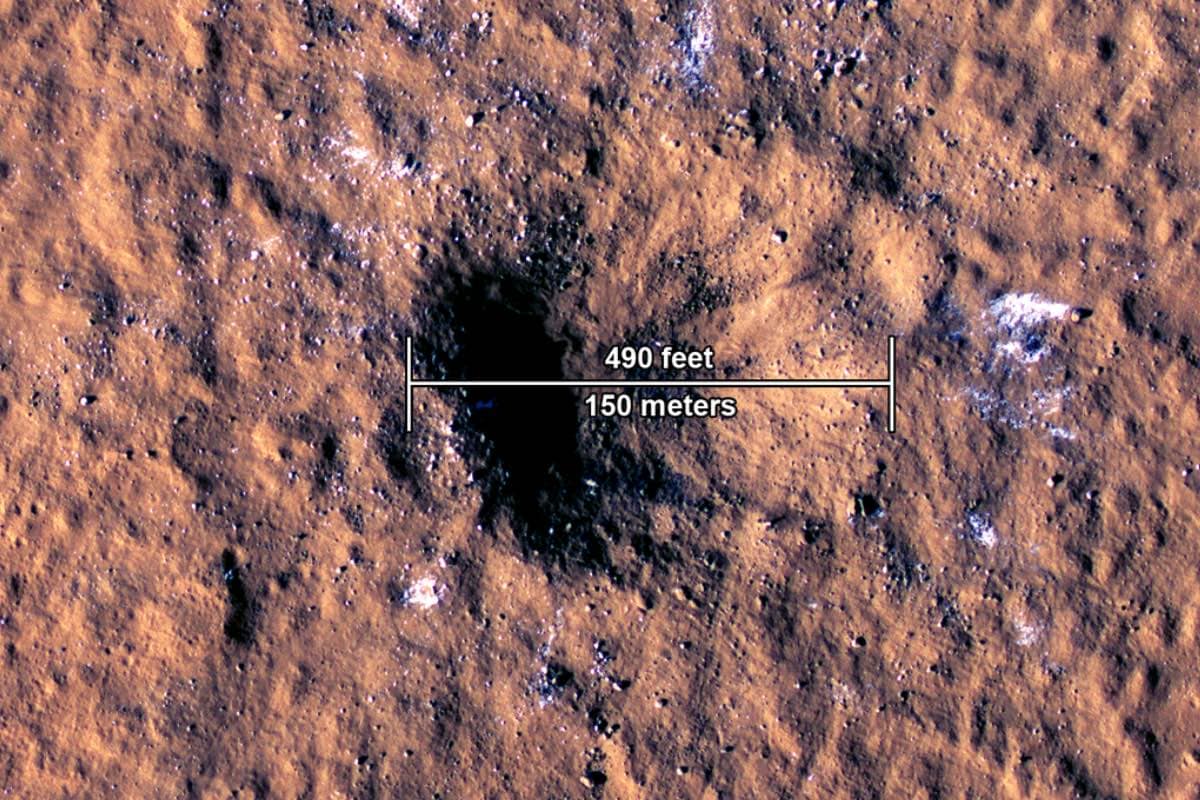Two NASA spacecraft at Mars — one on the floor and the opposite in orbit — have recorded the largest meteor strikes and influence craters but.
The high-speed barrages final 12 months despatched seismic waves rippling 1000’s of miles throughout Mars, the primary ever detected close to the floor of one other planet, and carved out craters practically 500 ft (150 meters) throughout, scientists reported Thursday within the journal Science.
The bigger of the 2 strikes churned out boulder-size slabs of ice, which can assist researchers search for methods future astronauts can faucet into Mars’ pure assets.
The Insight lander measured the seismic shocks, whereas the Mars Reconnaissance Orbiter supplied beautiful photos of the ensuing craters.
Imaging the craters “would have been enormous already,” however matching it to the seismic ripples was a bonus, mentioned co-author Liliya Posiolova of Malin House Science Programs in San Diego. “We have been so fortunate.”
Mars’ environment is skinny not like on Earth, the place the thick environment prevents most house rocks from reaching the bottom, as a substitute breaking and incinerating them.
A separate research final month linked a latest sequence of smaller Martian meteoroid impacts with smaller craters nearer to InSight, utilizing information from the identical lander and orbiter.
The influence observations come as InSight nears the top of its mission due to dwindling energy, its photo voltaic panels blanketed by mud storms. InSight landed on the equatorial plains of Mars in 2018 and has since recorded greater than 1,300 marsquakes.
“It should be heartbreaking once we lastly lose communication with InSight,” mentioned Bruce Banerdt of NASA’s Jet Propulsion Laboratory, the lander’s chief scientist who took half within the research. “However the information it has despatched us will definitely preserve us busy for years to return.”
The incoming house rocks have been between 16 ft and 40 ft (5 meters and 12 meters) in diameter, mentioned Posiolova. The impacts registered about magnitude 4.
The bigger of the 2 struck final December some 2,200 miles (3,500 kms) from InSight, making a crater roughly 70 ft (21 meters) deep. The orbiter’s cameras confirmed particles hurled as much as 25 miles (40 kms) from the influence, in addition to white patches of ice across the crater, essentially the most frozen water noticed at such low latitudes, Posiolova mentioned.
Posiolova noticed the crater earlier this 12 months after taking further photos of the area from orbit. The crater was lacking from earlier images, and after poring by means of the archives, she pinpointed the influence to late December. She remembered a big seismic occasion recorded by InSight round that point and with assist from that group, matched the recent gap to what was undoubtedly a meteoroid strike. The blast wave was clearly seen.
Scientists additionally realized the lander and orbiter teamed up for an earlier meteoroid strike, greater than double the space of the December one and barely smaller.
“Everyone was simply shocked and amazed. One other one? Yep,” she recalled.
The seismic readings from the 2 impacts point out a denser Martian crust past InSight’s location.
“We nonetheless have a protracted technique to go to understanding the inside construction and dynamics of Mars, which stay largely enigmatic,” mentioned Doyeon Kim of ETH Zurich’s Institute of Geophysics in Switzerland, who was a part of the analysis.
Exterior scientists mentioned future landers from Europe and China will carry much more superior seismometers. Future missions will “paint a clearer image” of how Mars developed, Yingjie Yang and Xiaofei Chen from China’s Southern College of Science and Know-how in Shenzhen wrote in an accompanying editorial.










